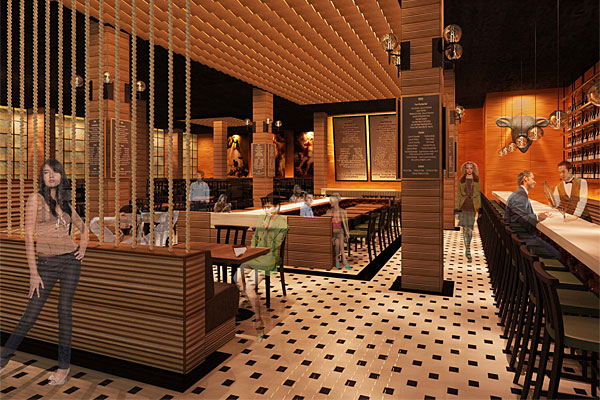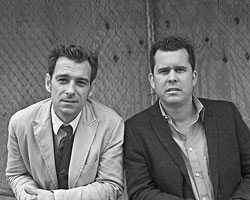
A rendering of Tavernita’s interior
The sprawling restaurant Tavernita, set to open in the old Martini Park space (151 W. Erie St.) in September with three separate bars inside, has been raising eyebrows for weeks. First came the news that the chef Ryan Poli would be leaving Perennial to head up this Latin concept from the group behind the nearby New York import Mercadito and its basement cocktail lounge, Double A (more photos here). Then came a press release about Tavernita’s beverage program—a missive that sent my own right arch aloft when I spotted the word “batchologist.”
Seeking a definition, I called Paul Tanguay, who, with his business partner, Tad Carducci, runs the beverage and bar consulting outfit Tippling Bros. and is masterminding Tavernita’s cocktail menu. Here’s the scoop.
The Chaser: Where are you guys based?
Paul Tanguay: New York City. We’ve had the business almost four years. We’ve done some work with major restaurant groups, a lot of spirits companies, and wine and sake importers. In July, we’re opening The Tippler, a new bar in the basement of [New York’s] Chelsea Market.

From left: Tad Carducci and Paul Tanguay, a.k.a. the Tippling Bros.
TC: I need to know: What’s a batchologist?
PT: We’re always doing the Aspen Food & Wine Classic, Tales of the Cocktail, the Manhattan Cocktail Classic. You’re serving 600 to 1,000 people in the space of three hours. It’s impossible to do à la minute [made to order] cocktails for crowds of that size. A lot of people in the industry do batch cocktails for events like that, and we’ve been joking around with the word for a while, but it’s actually an art. There’s something very funny about batching. If you take your recipe and multiply it by 100 or 200, it doesn’t always turn out the way you’d hope it would. So there’s a lot of tweaking involved.
TC: How does it work?
PT: We’re using cornelius kegs—kind of a bag in a box—which were originally used by the soda industry. You can buy them used these days, and many beer lovers use them to dispense homebrews. Unlike with a beer keg, where you need special machinery to hook it up and clean it out, it can all be done manually with the corny keg: Take the top off, clean it out, refill it.
TC: How does a kegged cocktail taste compared to one that’s made to order?
PT: It’s not that big of a taste difference. One of our objects with Tavernita is doing quality cocktails with fresh ingredients but to also have diversity. We’ll do some base mixes, add different stuff, and shake it, so it’s not always like a draw and pour with a beer. We can add fruits and flavors to create all sorts of unique things.
TC: So, we won’t get bored watching the bartenders?
PT: There’s still going to be theatre at the bar—that’s for sure. But we’re trying to move beyond the mustached, suspender-wearing mixologist and do something fun and different. This is a major restaurant . . . so the idea is to have quality and increase the speed of service.
TC: Our readers are always bemoaning the price of craft cocktails, as am I. Do kegs mean savings could be passed on to drinkers?
PT: I think the cocktails at Mercadito are already pretty reasonable, around $9 to $14. In this day and age, citrus is so expensive, and a lot of times, it’s not even good: You get no juice. When you have a fresh juice program, it’s difficult to keep the cost down. But we’re not going to charge $18 for a cocktail.
TC: Have you been to The Aviary? What do you think of their method of assigning one “bar chef” to each drink, in an effort to make the process faster?
PT: Well. What they’re doing is revolutionary. It’s great. But I’m not sure how the economics of it all works. I’m sure they have it figured out. We don’t need one person for one cocktail—think about it like pouring a beer. But our bartenders can still be creative because we’re making our own vermouth, sodas, a cola, a tonic, and red sangria on tap that can be modified as you want. And we’re still going to have some quote-unquote mixology at the bar. That’s what we do.
TC: Here’s another phrase from the press release: the “bottle-free future of wine.” Will this be the sommelier gasp heard ’round the world?
PT: There are always going to be bottles of wine, but I think the future is about asking: What is our carbon footprint? The beer industry has been doing kegs for a long time, and they have this system of keg exchange. A keg might come from one brewery one day, and it goes to another brewery after it’s empty. It’s a great sharing thing. Right now the cost of a bottle of wine—just the bottle, the foil, the cork, the paper—it’s over $1.25. With more bottleless wine, not only would we be saving, we wouldn’t be throwing out all that stuff. The art of the sommelier is still there, no matter what. He’s still going to be picking the wines that are coming out. But I don’t think somebody should shun the idea of kegged wine. The freshness is unparalleled. Corks are a very old closure that cause a lot of problems for wine.
TC: You say Tavernita will have three distinct beverage programs, one for each bar. That sounds like a lot of work.
PT: The idea is to break up the space. It’s a big place, and if you didn’t break it up, you’d lose intimacy. The main bar has 24 seats, and Barcito [a smaller bar carved out of a corner of the restaurant] will be the playground, with revolving food and beverage offerings almost daily. The third aspect, the elevated lounge, has more of a nightlife element to it. You kind of know what people are looking for in nightlife drinking: bottle service, tables, and a lot of people are vodka and Red Bull drinkers. Sometimes the market demands it.
Tavernita image courtesy of SEED Design


